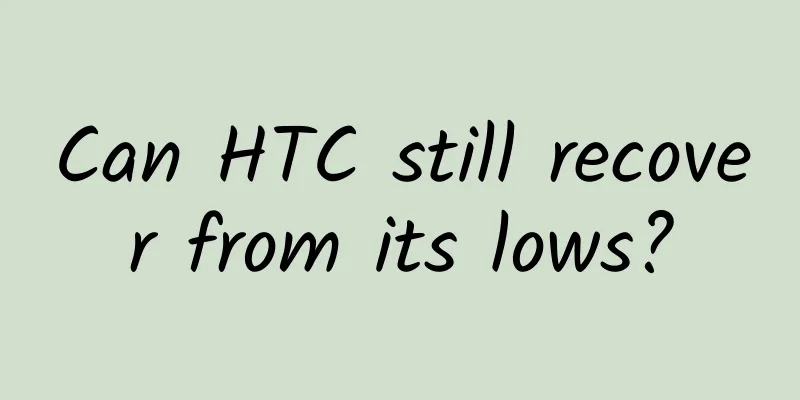Can HTC still recover from its lows?

|
HTC's declining performance in the past two years is obvious to all. You may still remember the glorious moment around April 2011 when HTC's market value surpassed Nokia for the first time. Three years later, although HTC released the new generation flagship phone HTCOne M8 this year, it still cannot stop the industry from classifying HTC with declining mobile phone brands such as Nokia and Motorola. By the end of 2013, HTC's market share had even fallen to less than 10%. HTC is also spending a lot of effort to reorganize its market strategy and positioning in an attempt to reverse the decline. So what we want to discuss is whether HTC, which is declining day by day, can regain its glory and fight a comeback? Let's look back at history. In the third quarter of 2011, HTC was the best-selling smartphone brand in the United States. In that quarter, HTC's own-brand smartphone shipments reached 5.7 million units, with a market share of nearly 25%, and it also surpassed Apple and Samsung to become the largest smartphone manufacturer in the United States. However, when the time came to 2012, HTC's share of the global smartphone market decreased by more than 50%, and by the end of 2013, HTC's market share had even fallen to less than 10%. What went wrong for HTC? We know that although HTC has been working hard to cope with various changes in the market, the industry knows that one of HTC's fatal mistakes was to abandon the "sea of machines" market strategy covering low, medium and high-end markets, which led to unclear positioning and subsequently reduced HTC's brand value. Many mobile phone users turned to Samsung, Xiaomi and China Cool Alliance. In addition, we all know that in the high-end Android market, HTC was hit by Samsung and had almost no chance to fight back. However, what we need to think about is why HTC lost to Samsung in the high-end market? This first has to start with the industrial chain system. We know that Samsung's industrial chain system is the most complete in the entire Android camp. Whether it is the upstream CPU, screen, chip, camera, etc., or the midstream mobile phone design and manufacturing, and even the downstream channels and sales, Samsung almost covers all aspects, that is, it has the advantage of horizontally integrated supply chain, which effectively ensures that Samsung can control time, price, and procurement costs, launch new products at the right time, not be constrained by external supply chain channels, and control the right to speak in the industrial chain, and at the same time will not cause shipment delays. Most of the core technologies that HTC controls now are concentrated on the user experience level, and core capabilities such as operating systems and chip technology have been absent for a long time. HTC also relies on other upstream and downstream manufacturers in the industry chain for supply of CPUs, screens, and chips. When there is a chip shortage, it needs to find chip manufacturers such as Qualcomm. Even many of HTC's mobile phones use Samsung screens, and face the risk of screen supply shortages at any time. This is a bit similar to domestic manufacturers such as Xiaomi and China Cool Alliance. If they encounter a situation where upstream manufacturers are short of parts or have been booked, they can only compromise and change materials or delay the launch of new products. From this, we can see that HTC basically has the supply chain shortcomings that China Cool Alliance and Xiaomi have. It lacks the control of the industry chain, bargaining power, product innovation and the core competitiveness of the brand itself, and also lacks Samsung's core technical advantages in hardware levels such as chips, cameras, sensors, CPUs, panels, memory and processors. In addition, for a long time, HTC has only played a design role in the entire mobile phone industry chain. Apart from the unique Sense UI that distinguishes it from other brands, HTC has deep traces of the OEM model and has not impacted the brand premium in the high-end market. Let's look at brand marketing. For HTC, brand marketing is probably the most entangled issue at present. In the brand ranking in marketing, according to Thomson Reuters data, among the top 20 companies in the world in terms of revenue, Samsung's advertising and marketing expenditure accounts for the largest proportion of annual revenue, reaching 5.4%, while HTC's marketing investment is quite different from Samsung. Therefore, HTC is far behind Samsung in terms of marketing, technology accumulation and industrial chain control capabilities. Therefore, in all aspects, HTC does not have the brand energy to challenge Samsung and impact the high-end market. From the perspective of the products themselves, HTC's entire product series does not have many high user stickiness and core selling points for users. Therefore, the starting point of HTC's decline is that HTC's early development was too smooth and it overestimated its own brand value. At the same time, we can see that the time point when HTC turned from prosperity to decline was exactly when it gave up the strategy of fully covering the high, medium and low-end user groups and turned to pursue the high-end route. On the other hand, when HTC began to pursue the high-end strategy, it had already passed the time bonus window for the early development of Android smartphones. Therefore, in my opinion, HTC's initial glory did not come from its core competitiveness that other companies could not replicate, but from the fact that it was at the forefront of a booming Android smartphone market. Wu Jun described in "The Top of the Wave": A company at the top of a wave can be pushed to a higher peak even if it does nothing. This is the same as what Lei Jun said about "pigs on the wind." The timing of HTC's cooperation with Google to launch the first Google phone, the G1, was long before Google acquired Android. HTC's peak of the wave was precisely due to the decline of Symbian and the collapse of Nokia, which led to the development of Android. As one of the earliest members of the Android camp, HTC, which fully covered high, medium and low-end models, was able to quickly capture the first batch of Android users and then rise accordingly. However, from 2012 to 2013, with the impact of Samsung in the high-end market and the rise of mainland mobile phone brands, mainly Xiaomi, the overall collapse of HTC, which had little achievement in innovation, was accelerated. The competitiveness of HTC was greatly reduced by the mainland domestic mobile phones with higher cost performance, better configuration at the same price, marketing strategies that better understand local users and operator channel advantages. In the mainland Chinese market, HTC still has not found its own positioning and calls itself an international brand. As a result, the prices of mobile phones with the same configuration and cost performance remain high, which has put HTC in an even more embarrassing situation. However, after so much complaints, in fact, if we look at it from another perspective, a lean camel is bigger than a horse. The declining HTC is not without the possibility of revival. For example, a good opportunity at present is the decline and decline of Samsung. This is not only an opportunity for China Cool Alliance and Xiaomi, but also an opportunity for HTC. In addition, we can see that HTC still has certain advantages at this stage. Compared with many mobile phone manufacturers, HTC is in good financial condition, with sufficient cash reserves and no losses or liabilities. At the same time, HTC still knows how to reflect on the mistakes of its own market strategy and quickly adjust its market strategy. For example, starting from February this year, Wang Xuehong first began to exert force in the mid-range market and released the 4G LTE smartphone Desire816 equipped with a 5.5-inch screen in Barcelona. Then, the high-end product HTC one was modified into a mid-priced fashion version and thrown into the mid-range market, and achieved sales of 50,000 units within 15 minutes. HTC's roundabout strategy of using high-end mobile phones to attack the mid-range market has a bit of the flavor of "Tian Ji's horse racing". In fact, it is the same as the cost-effective strategy of China Cool Union in China. This strategic awakening means that HTC is still a mobile phone manufacturer that responds to the market quickly. This also shows that HTC, as a company that has grown up in the dividends of the Android smart phone market, still has market power that cannot be underestimated. Until now, HTC's supply chain is still weak, its product innovation design is still criticized, and the frequent changes in senior management make HTC's future not optimistic to most people. However, we can see that with new products such as HTC One Fashion Edition, HTC One M8 and HTC New Desire series, HTC is making a full-scale attack on the high-end, mid-end and low-end markets. It seems that the "sea of machines" strategy that supported HTC's original glory is returning. The HTC team led by Wang Xuehong is also embracing the mid-end and low-end markets again, and bundling with operator channels to make all-round efforts. It is known that HTC's current mid-range strategy is not only facing Samsung, but also domestic brands will undoubtedly face stronger opponents in the future. Although the domestic low-end market is firmly controlled by Xiaomi with cost-effectiveness, if HTC can give users more highlights in cost-effectiveness and innovative design, HTC still has the ability to stir up the low-end and mid-end market. In addition, we can see that HTC's UltraPixes technology and optical zoom technology also show that it still has the ability to innovate. The team led by Wang Xuehong is also working hard to solve the supply chain problem. HTC's hiring of Paul Golden, a former marketing executive of Samsung, as Wang Xuehong's consultant and Robert Downey Jr. as the spokesperson show that HTC has begun to exert its efforts in brand marketing. In terms of marketing, it still depends on whether HTC can start with reshaping its brand image, relying on its own resource accumulation and market strategy adjustment, transforming its brand image and giving itself a correct market positioning. In the final analysis, if HTC wants to get out of the vicious cycle of repeated decline, it needs to make strategic adjustments while fully understanding future user needs. It needs to work hard to solve the shortcomings in the entire supply chain and brand marketing. We can see that HTC's courage to break through and market agility, although it is unable to recreate its original glory, still has the possibility of breaking the current decline. Today, the smartphone market is also facing an innovation dilemma, and users are also facing an aesthetic fatigue of the current undifferentiated smartphone market. Regardless of the mid-range, low-end and high-end markets, mobile phone users still expect more highlights and the possibility of diversified choices. For HTC, which is eager to revive, isn't this another time to accumulate momentum? As a winner of Toutiao's Qingyun Plan and Baijiahao's Bai+ Plan, the 2019 Baidu Digital Author of the Year, the Baijiahao's Most Popular Author in the Technology Field, the 2019 Sogou Technology and Culture Author, and the 2021 Baijiahao Quarterly Influential Creator, he has won many awards, including the 2013 Sohu Best Industry Media Person, the 2015 China New Media Entrepreneurship Competition Beijing Third Place, the 2015 Guangmang Experience Award, the 2015 China New Media Entrepreneurship Competition Finals Third Place, and the 2018 Baidu Dynamic Annual Powerful Celebrity. |
<<: Why IT tycoons were easily believed in the "drug abuse rumors"
Recommend
How much does it cost to develop a Panyu e-commerce mini program?
Although mini programs have been around for quite...
Are you venomous? Don't be afraid! Scientists have found a "cheap antidote" for cobra venom
Compiled by: Gong Zixin Cobra bites kill thousand...
Case Analysis: How to build a user portrait for a product?
Wandoujia has been drawing user portraits ( Perso...
Are humans the first civilization in the universe? Four scientific theories about aliens tell you the truth
This topic has been popular on the Internet for a...
Roewe RX5 upgrades to super-large panoramic sunroof and 1G data for free
Recently, it was reported that several models of ...
Advertising tips for the financial industry in November!
The November sale is just around the corner, and ...
From toxic gas to life guardian, this pharmacologist justifies nitric oxide
Nitric oxide (NO) was once generally regarded as ...
How will ByteDance react if Microsoft considers acquiring TikTok's UK business?
Microsoft considers acquiring TikTok's UK bus...
How to have a complete set of activity operation planning ideas!
As a novice in operations, how can you learn from...
Is your headache worse after taking painkillers? If you have these symptoms, you must go to the hospital!
Review expert: Peng Guoqiu, deputy chief physicia...
A fresh stream in the live broadcast industry, celebrities’ live broadcasts should be the transmitters of positive energy
When it comes to online live streaming, Internet ...
Shoot headshots with every shot! TV version of "Gunfire Frontline" trial play experience
On the current large-screen TVs, in addition to c...
SEM account performance is not good? 80% of the time it’s because you’re thinking wrongly!
After reading this article, I hope you can improv...
Is it worth doing B Station’s content e-commerce + live streaming sales?
Bilibili , which just released its financial repo...
Afraid of losing control of blood sugar and afraid to eat staple food? Take this staple food-friendly recipe, which is both sugar-controlling and delicious
I have diabetes One of the most painful things Do...









